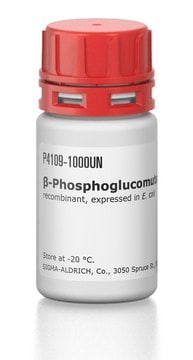P3397
Phosphoglucomutase from rabbit muscle
ammonium sulfate suspension, ≥100 units/mg protein
Synonym(s):
PGM, α-D-Glucose-1,6-bisphosphatase, α-D-Glucose-1-phosphate phosphotransferase
About This Item
Recommended Products
biological source
rabbit muscle
description
ammonium sulfate suspension, >=100 units/mg protein
form
ammonium sulfate suspension
specific activity
≥100 units/mg protein
storage condition
(Tightly closed)
technique(s)
activity assay: suitable
color
white to light yellow
foreign activity
lactic dehydrogenase ≤0.5%
phosphoglucose isomerase ≤0.01%
pyruvate kinase ≤0.05%
shipped in
wet ice
storage temp.
2-8°C
Looking for similar products? Visit Product Comparison Guide
General description
Phosphoglucomutase (PGM), a conserved enzyme, is abundantly found in animals, plants, and microorganisms. It is distributed in almost all tissues.
Application
- to study glycogenesis and phosphoglycomutase deficiency in humans
- in phosphoglucomutase assays to study metabolic regulation
- for assay A to assay enzymes closely linked to glycogen metabolism in transformed BL21(DE3)C43 cells
- in sucrose synthase (SuSy) andADPglucose pyrophosphorylase (AGPase) assays(3)
- in enzyme activity assay for coupling the reduction of nicotinamide adenine dinucleotide phosphate (NADP+)to determine glucose-1-phosphate from sucrose and inorganic phosphate (Pi)
Biochem/physiol Actions
Unit Definition
Physical form
Analysis Note
antibody
enzyme
Storage Class Code
12 - Non Combustible Liquids
WGK
WGK 2
Flash Point(F)
Not applicable
Flash Point(C)
Not applicable
Personal Protective Equipment
Certificates of Analysis (COA)
Search for Certificates of Analysis (COA) by entering the products Lot/Batch Number. Lot and Batch Numbers can be found on a product’s label following the words ‘Lot’ or ‘Batch’.
Already Own This Product?
Find documentation for the products that you have recently purchased in the Document Library.
Customers Also Viewed
Articles
Instructions for working with enzymes supplied as ammonium sulfate suspensions
Our team of scientists has experience in all areas of research including Life Science, Material Science, Chemical Synthesis, Chromatography, Analytical and many others.
Contact Technical Service










